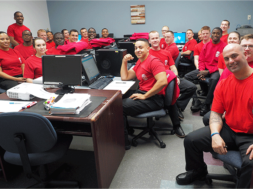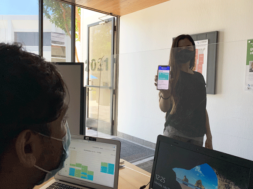
Leading During Difficult Times
By David J. Pauldine, Pauldine Enterprises, LLC
Taken from excerpts of presentations given at the Innovation Summit in Jackson Hole, Wyoming (February 2015), the Arizona Private School Association Annual Conference (May 2015) and the APSCU Annual Conference in Denver, CO (June 2015).
I do not need to elaborate on these being difficult times for private sector colleges and universities (PSCU’s). What is more important is to talk about how to lead during difficult times. Let us start with a mindset. There is a saying that captures it all:
DOWNLOAD ARTICLE‘You cannot always control what happens to you; you can only control how you respond to what happens to you.’
How PSCU leaders respond to challenging times is what is most important. So, let us take a look at smart steps to leading during a turnaround period. I call it: Ten tasks of leaders during difficult times…
- Do not be too slow to admit you are in difficult times
This is the ‘Cleopatra syndrome.’ You know, Cleo was the queen of ‘denial.’ There is a natural tendency for leaders to want to stay the course when hard times hit. After all, maintaining the status quo brings comfort. We say to ourselves, ‘we did not get dumb overnight.’ The people and the plan we have just gave us a period of much success, we do not need to change right now. Then, the days turn into weeks and months and a few years into the downturn it is too late to make a corrective change. Be alert and be quick. Admit the downturn and set a new course for the enterprise. - Model the values, vision and mission of the organization
Can you imagine coming to work each day not believing in what you do and why you do it? Now, multiply that times the number of employees you have in your organization. Critical here is the need to remind folks why they do what they do. Remind them of the good that your organization brings to the planet.Re-inspire around your cause, your reason for being, what you believe. We are not selling alcohol, tobacco or firearms here; we are changing lives.
Without this ‘grounding’ organizations cannot effectively manage a turnaround. No mission, no margin.
- Have a plan
I know. This is a no brainer. But, it is not an automatic. You still have to do it. You would be surprised how often this gets swept aside. Some guideposts while setting the plan: a) involve multiple layers or personnel in the development of the plan. Do not come down from the mountain with the tablets and tell the team you have the plan. They will resist having not had a hand in its development; b) ask yourself three questions: Where are we now? Where are we going? And, how will we get there? Then, build your plan around the answers. c) tough times call for bold actions. Do not tinker around the edges. Make some hard turns in the direction of your organization. Do not “incrementalize” your way to change. - Get the right people in the right roles
We know this one too. But, it can be hard to change out folks who were part of the rise during good times. Yet, the future depends on it. New challenges require new skill sets. Match the talents with the tasks that need to be performed. Making changes in key positions also sends a message of urgency to the rest of the organization. It lets people know you are serious and change is the highest priority. Of course, be respectful and humane in making these changes and where possible, re-assign talent before terminating talent. In the end, nothing matters more than getting the right talent in the right roles. - Communicate constantly
Remember that plan you and others developed? Now it is time to get out and sell it. Communicate, communicate, communicate. Leave no member of your organization absent the message of what your plan is to turn things around. Write it out and send the message via email. Then, hit the road and present it in your stump speech. Then videotape the message and send it out. Finish with an auto voice mail message sent to every phone across your enterprise. Recite the key components of the plan at every turn. Speak it ‘til your tired of hearing it. There is always someone who has not heard it, or always someone that prefers to resist the plan and stick to the old way of doing things. The more you talk it, the more it becomes real. - Ask for help
Sometimes hard to do, asking for help is resisted because it may mean you do not have all the answers. Nonsense.Asking for help is a show of strength, not weakness. It signals that you care about success above all else.
Maybe it is a consultant you need, or help from your parent organization, or a sister campus inside the family. Whatever the resource, do not hesitate to find it. Of course, you do no want to surrender control to this resource lest you lose the right to lead. But, the help you get from the right resource can complete the puzzle and ignite the change you seek.
- Disrupt the status quo
This is my favorite. It is time to break rituals, stop doing things that are tradition, start doing things that are different. Make noise around the need to disrupt the status quo. Go to meetings you never used to attend and stop attending others that you always participated in. Change the words or terms your organization uses as a matter of course, so as to make people think differently. Get the team out of its trance by whatever means necessary. Break with old habits that add no value. Hard times require an agile, alert workforce. If that workforce is stuck in rituals that add no value there will not be the fuel or energy for change. - Adapt leadership style to the situation
Time to ask more questions. Time to challenge more of the information you receive from your people. Time to push new buttons and activate. What may have been an OK answer from someone now gets questioned further. The idea is to demonstrate to the team that there is much less room for error in difficult times so they have to get things right. The fun is still there. The trust is still there. The humanity is still there. It is just that you are seen as more focused, introducing more discipline, and if necessary, willing to engage in uncomfortable acts if it is what is needed. Candor prevails here. Admit mistakes and get hold of your organization’s culture. - Say NO to non-essentials
Remember the phrase, ‘ I can do anything, I just cannot do everything’? Well that is what this is all about. Time to prioritize. That a new idea is a good one may be something everyone agrees with, but ask ‘is it an appropriate idea for these times? There is no room for wasted energy. Everyone needs to be on task to what is most important to complete the turnaround. Everything else can go undone. We sometimes mistake motion for progress – doing lots of things makes us feel like we are getting there. But, in reality, the motion gets in the way of what is truly important and therefore slows down the recovery. Tough to do sometimes, but saying ‘NO’ to non-essential activity is critically important when time is of the essence. - Have an event symbolic of the change you want to create
People remember ceremonies. In 2005 a service company was found to be considered ‘old and tired’ by its customers. Their technology was dated and their practices ‘old school.’ The CEO called everyone outside into the parking lot and gave a speech. She then turned their attention to an upper floor of their headquarters. At that time, the CIO opened a window and tossed an old CRT terminal out the window and it shattered in the parking lot. Then, the tech team unveiled the new flat screen monitors that the company was deploying beginning immediately. The employees cheered. Everyone then received a ‘tchotchke’, which was a miniature flat screen monitor with the new turnaround slogan written on the front panel. Sounds a bit corny, but this stuff works.If you and your organization are about to take a stand on a big initiative, come up with an event – or series of events – that will help cement the new direction in the minds and hearts of your workforce.
I hope this article helps you and your team effectively lead the turnaround that you may be facing at your institution. And, I look forward to writing an article down the road entitled: “Managing during periods of peak performance”!

David J. Pauldine is a professional speaker, entrepreneur and active professional. He currently provides services under Pauldine Enterprises, LLC. Pauldine serves on the board of Quinstreet (QNST: Nasdaq) and Education Partners – a Willis Stein company, is active as a speaker, moderator and panelist at conferences, consults with private equity and is an investor in various real estate interests.
Paudline retired as President of DeVry University and Executive Vice President of DeVry Education Group in June 2014. As chief executive of the university, from 2006 to 2014 Pauldine was responsible for an institution which at its peak served 90,000 students.
Pauldine has invested 35 years in private sector high education. His career started at DeVry where he held a variety of positions from 1979 to 1988. In 1989, he joined Education Management Corporation (EDMC) where he served for 16-years. He was president of The Art Institutes system of schools from 2000 to 2005. While at EDMC, he also was chief marketing officer and college president of the Seattle and Fort Lauderdale campuses. Pauldine returned to DeVry in 2005.
Pauldine has considerable experience in speaking to the investment community and has done so by presenting at several conferences including William Blair, Stifel Nicolas and multiple Investor Day events. Additionally, he has presented at such conferences as the Marcus Evans Leadership Summit, Forum Events Human Resources Conference, The United States Olympic Committee Career & Education Summit, The Association of Private Sector Colleges and Universities (APSCU) Leadership Institute, The APSCU Annual Conference, The Jackson Hole Innovation Summit, The Higher Learning Commission Annual Conference, Arizona Private School Association Annual Conference, The Association of Independent Colleges & Schools Leadership Institute, ERE Recruiting Conference, LeadsCon, Talent Management Alliance and Northwest Association of Career Colleges annual conference.
Mr. Pauldine is past chairman of the board of APSCU.
Contact Information: David Pauldine // Pauldine Enterprises, LLC // 630-936-6121 // djpauldine@gmail.com // www.davidpauldine.com










